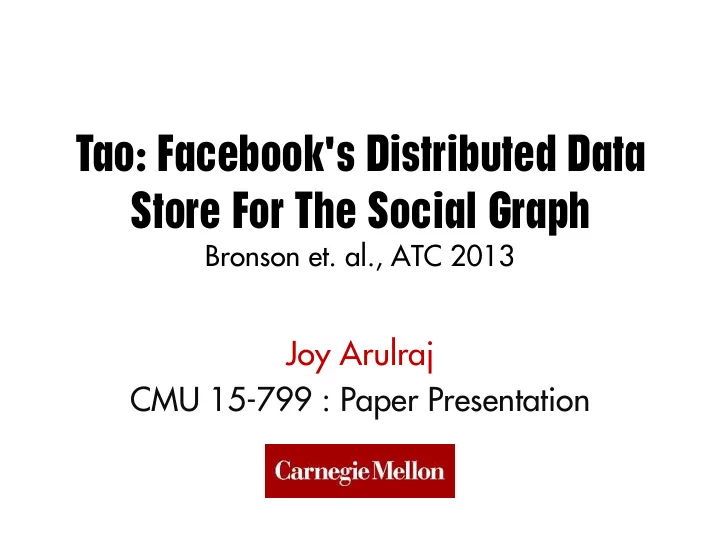

Tao: Facebook's Distributed Data Store For The Social Graph Bronson et. al., ATC 2013 Joy Arulraj CMU 15-799 : Paper Presentation
Talk Overview • Graph-aware cache backed by a database – Efficiency vs. consistency
Motivation • Memcached – Distributed in-memory key-value store – Memory object caching system – Data mapping in client code (PHP API)
Limitations • Association lists – Get entire list to update one edge • Control logic – Clients manage lookaside cache – But, only have a local perspective • Expensive read-after-write consistency – Writes forwarded to master – Local state updated asynchronously
Problem Statement • Need a “smart” caching layer – Graph-aware – Distributed cache management – Provides read-my-write consistency • Solution – Fix the API and leverage its constraints !
Example Alice was at CMU with Bob Cathy : Wish we were there ! David likes this Id : 200 otype : User Id : 600 otype : LOCATION name: Alice name: CMU LOC Id : 300 otype : User name: Bob FRIEND Id : 700 otype : CHECKIN Id : 400 otype : User CMT name: Cathy Id : 500 otype : USER Id : 800 otype : COMMENT LIKES name: David text: Wish we were there !
Data Model • Object – (id) -> (otype, (key->value)*) – Entities, repeatable actions – Ex: users, comments • Association – (id1, atype, id2) -> (time, (key->value)*) – Relationships, actions that model state transitions – Ex: tagged at, likes
Data Model • Association List – (id1, atype) -> [a new ,…,a old ] – Supports the Association Query API – Ex: (“CMU”, “COMMENT”)
API • Association API – assoc_add(id1, atype, id2, time, (k->v)*) – assoc_delete(id1, atype, id2) • Association Query API – [POINT] assoc_get(id1, atype, id2) – [RANGE] assoc_range(id1, atype, pos, limit) – [COUNT] assoc_count(id1, atype)
Client Queries • All queries start from an <id, atype> • 5 most recent comments on Alice’s checkin – assoc_range (“Alice”, “COMMENT”, 0, 5) • Number of friends of Bob – assoc_count (“Bob”, “FRIEND”)
Tao’s Goals • Low read latency • Write consistency • High read availability
Basic Architecture Webservers - Stateless Cache servers - Objects, Association Lists - Partitioned based on <id> TAO Database - Partitioned based on <id>
Low Read Latency Webservers - Too many network hops Cache servers - Hotspots with smaller shards
Datacenter-level Scalability Tiers - Distributed write logic Database - Thundering herds
Splitting the cache layer Follower Cache Leader Cache
Write Consistency • Followers – Absorb read hits – Forward read misses and writes to leaders – Write-through cache • Leader updates – Synchronously sent in reply to writer – Asynchronously sent to other followers
Write consistency • Leaders – Serialize concurrent writes – Can prevent “thundering herds” • Association list updates – Refills instead of invalidates – Idempotent pull-based incremental updates
Multi-datacenter Scalability Forwarded writes Master Replica Async DB replication Datacenter Datacenter
High Read Availability • Follower failure – Client contacts backup follower tier – May break read-after-write consistency • Leader failure – Follower tiers reroute read misses directly to DB – Writes sent to another member of leader tier
Handling Hot Spots • Consistent hashing – Simplifies cluster expansion – Request rerouting • Load balancing – Shard cloning – Small client-side cache
Results • Reads dominate writes – 99.8% read requests – 40% of requests are range queries • Most edge queries have empty results – Tao can use cached assoc_count – Key advantage of app-aware caching
Results • Availability – Fraction of failed queries : 4.9*10 -6 • Follower Throughput – 8 core Xeon + 144GB RAM + 10Gb Ethernet – 30-60K requests/sec
Tao Summary • Low read latency – Application-aware cache layer • Write consistency – Replication model • High read availability – Fault-tolerance
Talk Summary • Graph-aware cache backed by a database – Efficiency vs. consistency • Why did they not use a graph database ? – They trust MySQL – Tao’s cache layer handles their demands Thanks !
Recommend
More recommend